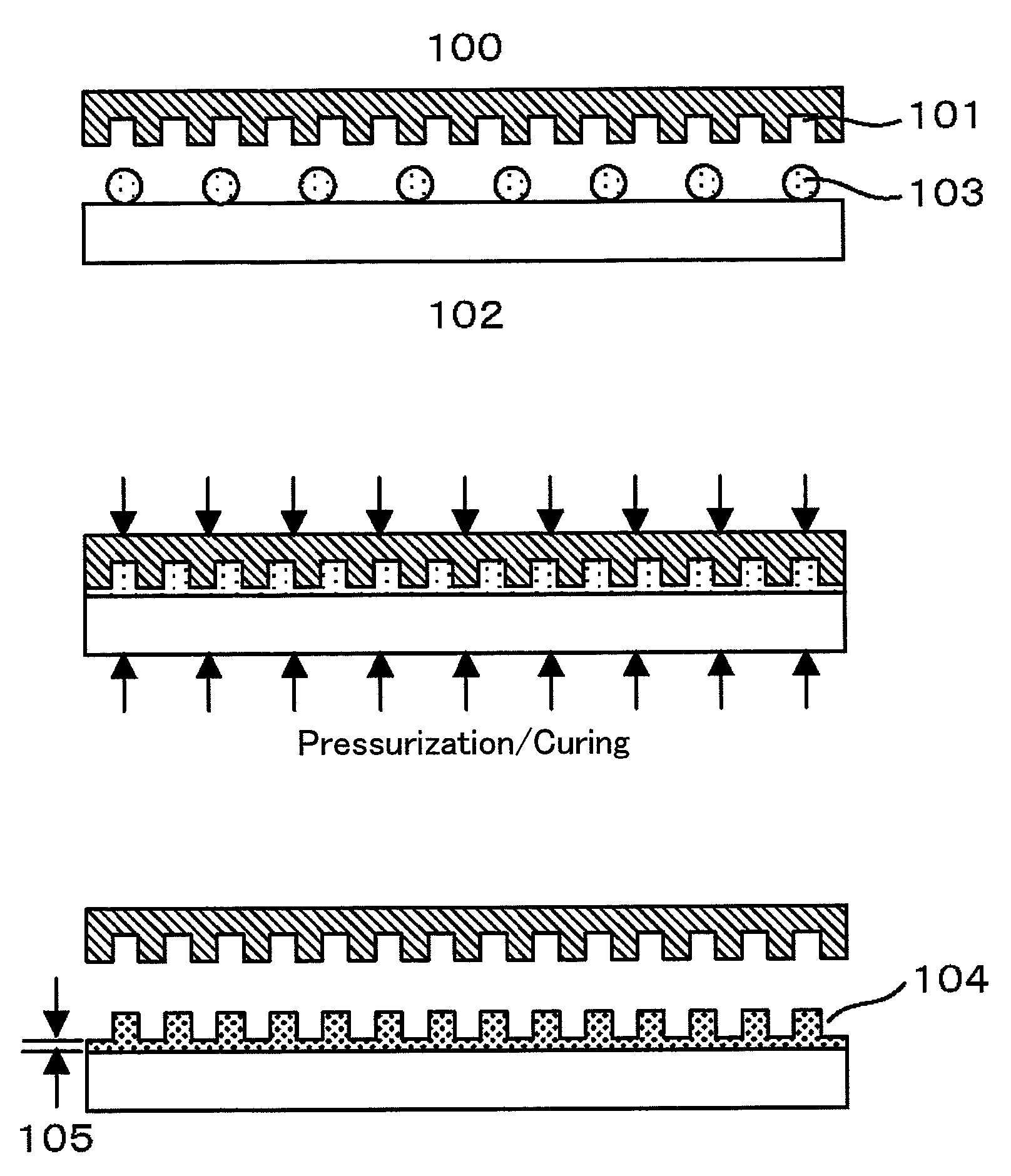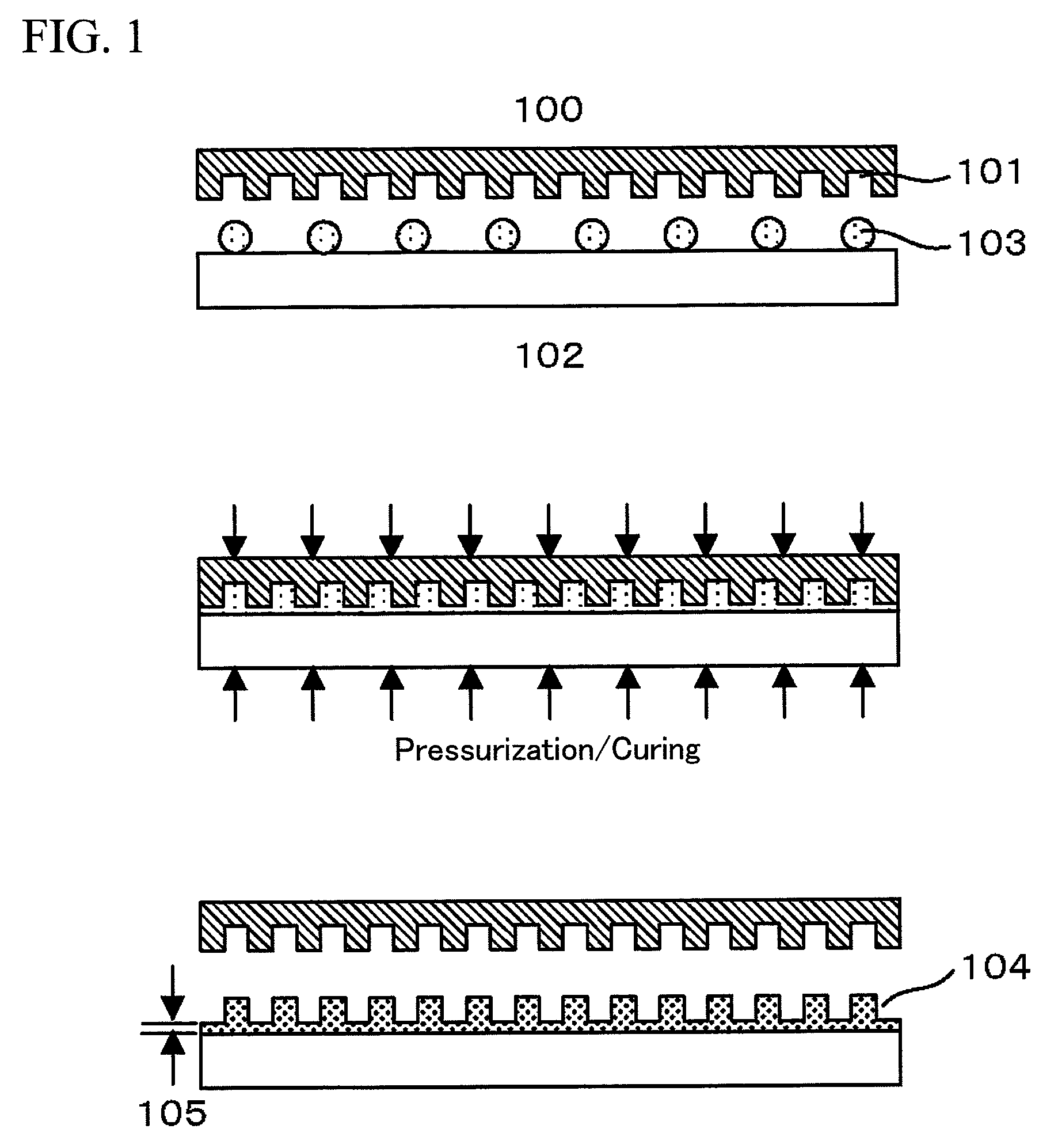Photo nanoimprint lithography
a technology of photo nano-imprinting and lithography head, which is applied in the field of photo nano-imprinting lithography, can solve the problems that the resist reaction cannot be controlled sometime, and the distribution of film thickness is hardly controlled, so as to improve the positioning characteristics of the head and enhance the processing accuracy of the geometry of the servo pattern
- Summary
- Abstract
- Description
- Claims
- Application Information
AI Technical Summary
Benefits of technology
Problems solved by technology
Method used
Image
Examples
example 1
[0103]In the present example, a groove structure was formed in a disc substrate.
[0104]An employed substrate 102 was a discoid glass substrate having a diameter of 65 mm, a thickness of 0.6 mm, and a diameter of the center hole Hb of 20 mm. The edge part of the periphery and the edge part of the center hole in the substrate 102 were previously chamfered by a width of 0.15 mm. The substrate 102 was immersed in a solution containing 1% of phenethyl trimethoxysilane in a solvent of 2-propanol, and was heated therein at 70° C. for 1 hour. Subsequently, the substrate 102 was cleaned with 2-propanol twice, was dried, and then was dried at 120° C. for 10 minutes to obtain an intermediary layer 102a thereon with a film thickness of 1.2 nm. A resin material 103 was instilled drop-wise on the surface of the substrate 102 with an ink-jet technique right before a nanoimprint operation. The resin was an acrylate-based photo-curable resin to which a photosensitive material was added, and had a vis...
example 2
[0108]An intermediary layer was formed with the use of various silane coupling agents in a similar procedure to that in Example 1, and the fine geometry was imprinted onto the resist. The results on the film thickness and the surface roughness Ra of the base layer will now be described below. Specifically, the silane coupling agent expressed by the following chemical formula was used.
Y—Si—(OCH3)3 (Chemical Formula 2)
[0109]At first, an intermediary layer 102a was formed on the surface of a substrate of a quartz disc having a smooth surface, and the contact angle against water was evaluated. Then, the intermediary layer 102a was formed on the substrate of the quartz disc, the pattern was imprinted thereon, and the thickness of the base layer and the surface roughness Ra were evaluated. The results are shown in Table 1. In Table 1, the thickness of the base layer and the surface roughness Ra are values including the thickness of the intermediary layer 102a.
[Table 1]
[0110]
TABLE 1Resul...
example 3
[0113]Different amounts per one droplet of a resist 103 were instilled drop-wise on the substrate by an ink-jet technique in a similar procedure to that in Example 1, and the fine geometry was imprinted onto the resist. The results on the film thickness and surface roughness Ra of the base layer will now be described below. Table 2 shows the results of the film thickness and surface roughness Ra of the base layer formed by changing the instilled amount per one droplet of the resist 103.
[Table 2]
[0114]
TABLE 2Imprint result when instilled amount per one droplet was changedInstilled amount perThickness (nm)one droplet (p1)of base layerRa (nm)0.00127460.005192150221010028125005682
[0115]When the instilled amount per one droplet of the resist 103 was 0.001 pl, the thickness of the base layer was 27 nm, the surface roughness Ra was 46 nm, and the base layer 105 caused thickness distribution therein. This was thought to be because the droplets were too small, it was difficult to control the...
PUM
| Property | Measurement | Unit |
|---|---|---|
| width | aaaaa | aaaaa |
| contact angle | aaaaa | aaaaa |
| contact angle | aaaaa | aaaaa |
Abstract
Description
Claims
Application Information
 Login to View More
Login to View More - R&D
- Intellectual Property
- Life Sciences
- Materials
- Tech Scout
- Unparalleled Data Quality
- Higher Quality Content
- 60% Fewer Hallucinations
Browse by: Latest US Patents, China's latest patents, Technical Efficacy Thesaurus, Application Domain, Technology Topic, Popular Technical Reports.
© 2025 PatSnap. All rights reserved.Legal|Privacy policy|Modern Slavery Act Transparency Statement|Sitemap|About US| Contact US: help@patsnap.com



